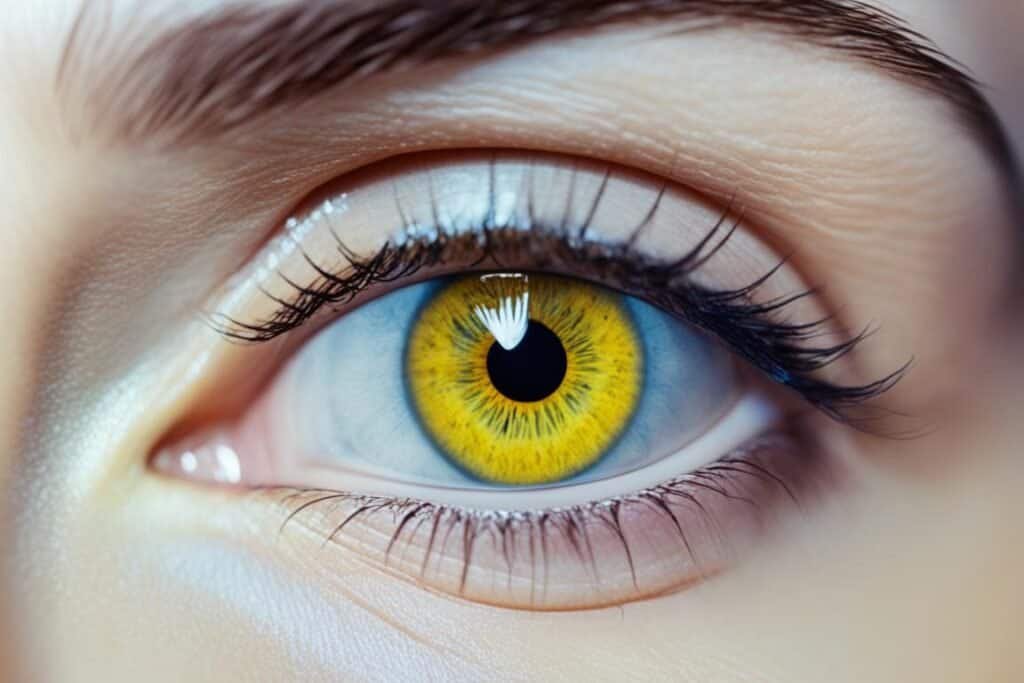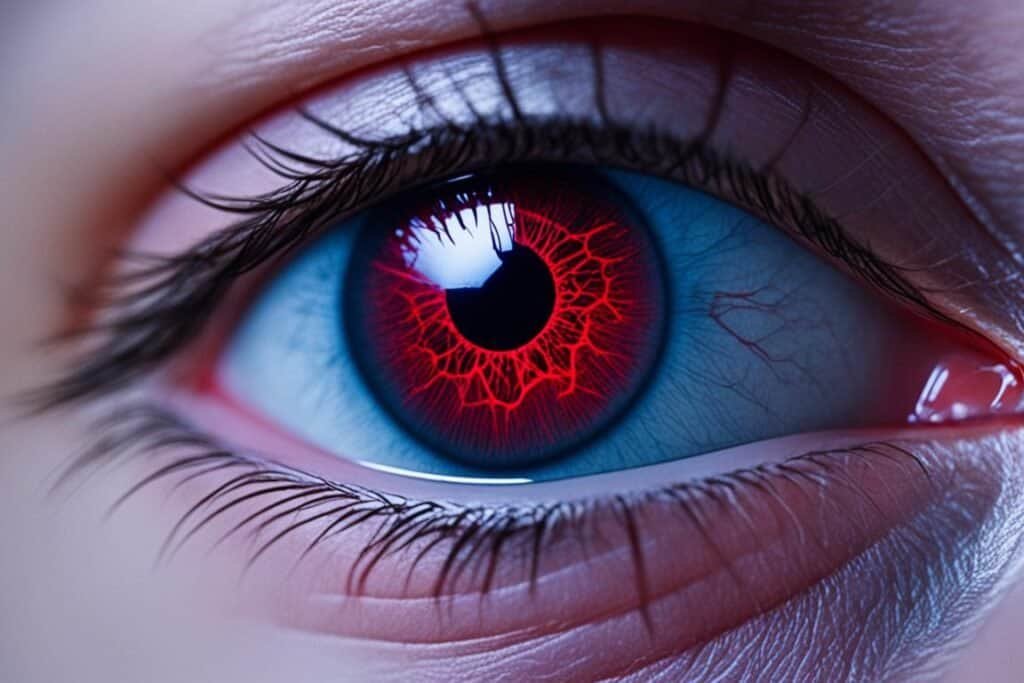High cholesterol levels can have a significant impact on your vision health. While most people associate cholesterol with cardiovascular health, it is essential to understand its effects on eye health as well. When cholesterol levels are elevated, it can lead to various eye conditions and vision impairment.
Key Takeaways:
- High cholesterol can affect your eye health and lead to vision problems.
- Elevated cholesterol levels can cause symptoms such as blurry vision, dark spots, and eye pain.
- Conditions like xanthelasma, arcus senilis, retinal vein occlusion, and Hollenhorst plaque are associated with high cholesterol.
- Regular cholesterol management and lifestyle changes can help reduce the impact of cholesterol on vision health.
- Consulting with healthcare providers and getting regular eye exams are crucial for maintaining healthy vision.
Signs and Symptoms of High Cholesterol in the Eyes
High cholesterol can have a noticeable impact on your eyes, resulting in various signs and symptoms that shouldn’t be ignored. One common symptom associated with high cholesterol is xanthelasma. These are yellowish areas that can appear around your eyes or near the nose. Xanthelasma is caused by cholesterol deposits in the skin, and its presence may indicate high cholesterol levels in your body.
Another sign of high cholesterol that can be observed in the eyes is arcus senilis. This refers to the formation of a colored ring around your cornea. While arcus senilis doesn’t affect your vision, it can serve as an indication of elevated cholesterol levels.
In more severe cases, high cholesterol can lead to conditions such as retinal vein occlusion and Hollenhorst plaque. Retinal vein occlusion occurs when a blood clot blocks the vein in your retina, potentially causing vision changes and impaired blood flow. Hollenhorst plaque, on the other hand, refers to the buildup of cholesterol that blocks small arteries within your eye. This can result in sudden vision loss or impairment.
It’s important to note that these eye symptoms of high cholesterol are not definitive proof of the condition, but they serve as potential indicators. If you notice any of these signs or symptoms in your eyes, it’s crucial to consult with a healthcare professional for proper diagnosis and cholesterol management.
| Signs and Symptoms | Description |
|---|---|
| Xanthelasma | Yellowish areas around the eyes or near the nose |
| Arcus Senilis | Colored ring around the cornea |
| Retinal Vein Occlusion | Blockage of the vein in the retina, leading to vision changes and impaired blood flow |
| Hollenhorst Plaque | Buildup of cholesterol that blocks small arteries within the eye, potentially causing sudden vision loss |
Xanthelasma: A Common Cholesterol-Related Eye Condition
Xanthelasma is a prevalent eye condition associated with high cholesterol levels in the body. These small, yellowish fatty deposits form in the skin around the eyes, particularly in the upper eyelids and near the nose. Although xanthelasma is generally a benign condition that does not cause pain or vision changes, it serves as an indication of high cholesterol.
If you notice yellowish patches or bumps around your eyes, it’s essential to consider the possibility of high cholesterol and seek further medical evaluation. Xanthelasma can be a visible sign that warrants attention to address and manage cholesterol levels.

Understanding Xanthelasma and Cholesterol Deposits
Xanthelasma results from the accumulation of cholesterol deposits in the skin layers around the eyes. These deposits, also known as xanthomas, are composed of lipids and macrophages, which are immune cells that engulf excess cholesterol.
While the exact cause of xanthelasma remains unclear, it is believed to be linked to genetic factors, as well as underlying high cholesterol and lipid imbalances in the body. Individuals with elevated levels of low-density lipoprotein (LDL) cholesterol, commonly referred to as the “bad” cholesterol, are more likely to develop xanthelasma.
Treatment Options for Xanthelasma
If xanthelasma is causing cosmetic concerns or you wish to remove the deposits, there are several treatment options available:
- Topical Medications: Dermatologists may recommend applying medications such as trichloroacetic acid or bichloroacetic acid to gradually dissolve the cholesterol deposits.
- Laser Treatment: Laser therapy can help vaporize the fatty deposits, allowing for smoother skin in the affected area.
- Surgical Excision: In some cases, surgical excision may be necessary to remove the deposits. This procedure is typically performed by a dermatologist and involves carefully cutting out the xanthelasma.
It’s important to note that removing xanthelasma does not address the underlying high cholesterol levels. To effectively manage cholesterol and reduce the risk of further xanthelasma development, it is crucial to make lifestyle changes such as adopting a heart-healthy diet, engaging in regular physical activity, and following any prescribed cholesterol-lowering medications.
Xanthelasma Prevention
While xanthelasma may not be completely preventable, there are steps you can take to help maintain healthy cholesterol levels and potentially reduce the risk of developing these deposits:
- Eat a Balanced Diet: Incorporate foods rich in fiber, whole grains, fruits, and vegetables while limiting saturated and trans fats.
- Exercise Regularly: Engage in moderate-intensity physical activity for at least 150 minutes per week.
- Maintain a Healthy Weight: Aim for a body mass index (BMI) within the normal range and consult with your healthcare provider for personalized weight management recommendations.
- Quit Smoking: Smoking can contribute to high cholesterol levels and increase the risk of xanthelasma development.
- Manage Cholesterol Levels: Regularly monitor your cholesterol levels and work with your healthcare provider to develop a personalized cholesterol management plan.
By adopting a proactive approach to cholesterol management and making healthy lifestyle choices, you can promote overall well-being and potentially reduce the risk of cholesterol-related eye conditions like xanthelasma.
| Xanthelasma Facts | |
|---|---|
| Signs and Symptoms | Small, yellowish fatty deposits in the skin around the eyes |
| Location | Upper eyelids and near the nose |
| Cause | High cholesterol and lipid imbalances |
| Treatment Options | Topical medications, laser treatment, surgical excision |
| Prevention | Healthy diet, regular exercise, weight management, smoking cessation, cholesterol monitoring |
Arcus Senilis: Cholesterol Deposits in the Cornea
Arcus senilis is a condition characterized by the presence of a white or grayish ring in the peripheral region of the cornea, the transparent layer at the front of the eye. This ring is formed as a result of cholesterol deposits in the eye, also known as corneal arcus. While arcus senilis itself does not typically cause vision impairment, it serves as an indication of elevated cholesterol levels within the body.
Arcus senilis is more commonly observed in older adults and may be associated with a family history of high cholesterol. The peripheral corneal ring is a visible sign that warrants attention to cardiovascular health and cholesterol management.
Retinal Vein Occlusion: A Severe Eye Condition Linked to High Cholesterol
Retinal vein occlusion is a serious eye condition that occurs when the vein in the retina becomes blocked, leading to a disruption of blood flow. This blockage can cause blood and fluid leakage, as well as swelling in the macula, which is essential for clear central vision.
High cholesterol is a common risk factor for retinal vein occlusion. When cholesterol levels are elevated, it can contribute to the formation of plaque in the blood vessels. Over time, this plaque buildup can block the vein in the retina, leading to the development of retinal vein occlusion.
The consequences of retinal vein occlusion can be significant. Individuals with this condition may experience a range of symptoms, including blurry vision, changes in vision, the appearance of dark spots or lines in their visual field, and pain in the affected eye.
Early detection and cholesterol management are crucial for preventing further vision loss. Regular eye exams are essential for identifying any signs of retinal vein occlusion. If diagnosed, lifestyle modifications and cholesterol-lowering treatment may be recommended to reduce the risk of progression and preserve vision.
By effectively managing cholesterol levels, individuals can decrease their risk of retinal vein occlusion and other eye conditions associated with high cholesterol. Careful cholesterol management, in conjunction with a healthy lifestyle, can help individuals maintain optimal eye health and reduce the impact of blood vessel blockage on their vision.

Don’t let high cholesterol put your vision at risk. Take control of your cholesterol levels today to safeguard your eye health and prevent vision loss.
Hollenhorst Plaque: A Sign of Cholesterol Buildup in the Eye
Hollenhorst plaque refers to a buildup of cholesterol that can block small arteries within the eye. These plaques often originate from larger arteries, such as the carotid artery. When a Hollenhorst plaque obstructs blood flow to the retina, it can lead to branch retinal artery occlusion, causing sudden vision loss or impairment. Furthermore, the presence of Hollenhorst plaque increases the risk of a cholesterol plaque traveling to the brain, potentially causing a stroke.
Risk of Vision Loss due to Hollenhorst Plaque
Hollenhorst plaque poses a significant risk to vision health due to the obstruction it causes within the eye’s arteries. When the plaque blocks the branch retinal artery, it prevents oxygen and nutrients from reaching the retina, resulting in sudden vision loss or impairment in the affected area. The extent of vision loss depends on the size and location of the blocked artery.
| Key Points | Details |
|---|---|
| Hollenhorst Plaque | A buildup of cholesterol in small eye arteries |
| Origin | Often originates from larger arteries, such as the carotid artery |
| Consequences | Blocks blood flow to the retina leading to branch retinal artery occlusion |
| Risk | Increases the risk of a cholesterol plaque traveling to the brain, potentially causing a stroke |
Conclusion
High cholesterol can have a significant impact on your vision health. Conditions like xanthelasma and arcus senilis may seem benign, but they can indicate elevated cholesterol levels in your body. More serious eye conditions such as retinal vein occlusion and Hollenhorst plaque are directly linked to high cholesterol and can lead to vision loss if left untreated.
To safeguard your vision, it’s important to prioritize cholesterol management. Early detection through regular eye exams and consultation with healthcare providers is crucial. By managing your cholesterol levels and making lifestyle changes such as adopting a low-fat diet, you can reduce the risks associated with high cholesterol and maintain healthy vision.
Remember, your eyes are a precious asset and deserve proactive care. Take the necessary steps to protect your vision and overall well-being. Prioritize healthy vision maintenance by keeping an eye on your cholesterol levels, implementing cholesterol management strategies, and seeking professional guidance whenever needed.

